
Joshua Conrad Jackson
@joshcjackson.bsky.social
Cultural evolution of the mind | Assistant Professor @ University of Chicago, Booth School of Business & Faculty Affiliate of UChicago Data Science Institute | He/his | https://joshuaconradjackson.com
And last but not least, Obshonka and colleagues find that Roman rule explains puzzling variation in modern well-being differences across Germany
Ancient Roman investment in infrastructure may explain why Southwestern Germans are so happy and healthy today
www.sciencedirect.com/science/arti...
Ancient Roman investment in infrastructure may explain why Southwestern Germans are so happy and healthy today
www.sciencedirect.com/science/arti...

November 4, 2025 at 4:03 PM
And last but not least, Obshonka and colleagues find that Roman rule explains puzzling variation in modern well-being differences across Germany
Ancient Roman investment in infrastructure may explain why Southwestern Germans are so happy and healthy today
www.sciencedirect.com/science/arti...
Ancient Roman investment in infrastructure may explain why Southwestern Germans are so happy and healthy today
www.sciencedirect.com/science/arti...
Samani and Baumard map out trends in Romantic love in Persian literature from 10th century to 20th century CE. They find an increasing emphasis on romantic love over time, particularly during the Safavid era. This may reveal a link w economic development
www.sciencedirect.com/science/arti...
www.sciencedirect.com/science/arti...

November 4, 2025 at 4:03 PM
Samani and Baumard map out trends in Romantic love in Persian literature from 10th century to 20th century CE. They find an increasing emphasis on romantic love over time, particularly during the Safavid era. This may reveal a link w economic development
www.sciencedirect.com/science/arti...
www.sciencedirect.com/science/arti...
Fan and Baumard reveal new evidence of rising individualism over history, which suggests that wealth rather than Protestantism contributed to individualism
www.sciencedirect.com/science/arti...
www.sciencedirect.com/science/arti...

November 4, 2025 at 4:03 PM
Fan and Baumard reveal new evidence of rising individualism over history, which suggests that wealth rather than Protestantism contributed to individualism
www.sciencedirect.com/science/arti...
www.sciencedirect.com/science/arti...
McClain and Kenny dig into the history of collectivism in Japan, conducting a pre-registered analysis of self-reported collectivism and tightness in the Japanese social survey and linking responses to historical subsistence patterns across Japan
www.sciencedirect.com/science/arti...
www.sciencedirect.com/science/arti...

November 4, 2025 at 4:03 PM
McClain and Kenny dig into the history of collectivism in Japan, conducting a pre-registered analysis of self-reported collectivism and tightness in the Japanese social survey and linking responses to historical subsistence patterns across Japan
www.sciencedirect.com/science/arti...
www.sciencedirect.com/science/arti...
@joannaschug.bsky.social leads a paper on gendered racial stereotypes. They show that the civil rights movement coincided with a rise in language about black men, but not black women
www.sciencedirect.com/science/arti...
www.sciencedirect.com/science/arti...
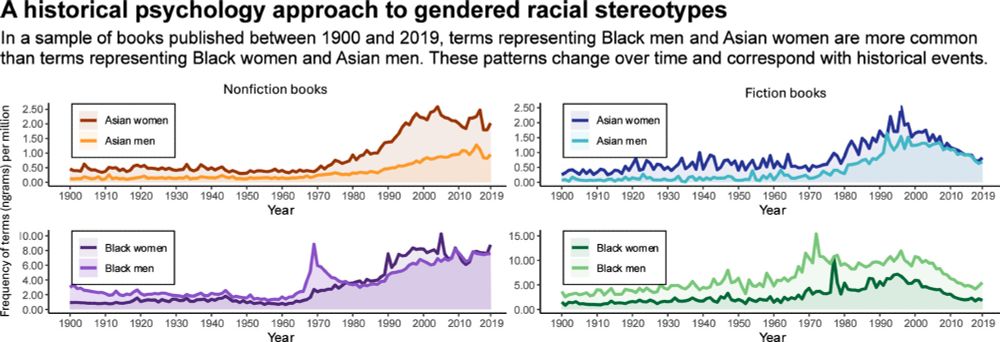
November 4, 2025 at 4:03 PM
@joannaschug.bsky.social leads a paper on gendered racial stereotypes. They show that the civil rights movement coincided with a rise in language about black men, but not black women
www.sciencedirect.com/science/arti...
www.sciencedirect.com/science/arti...
@mohammadatari.bsky.social and I begin with an editorial reflecting on the origins, current trends, and future of historical psych
The future requires strong causal identification and theorizing about how institutions can cement or change historical trends
www.sciencedirect.com/science/arti...
The future requires strong causal identification and theorizing about how institutions can cement or change historical trends
www.sciencedirect.com/science/arti...

November 4, 2025 at 4:03 PM
@mohammadatari.bsky.social and I begin with an editorial reflecting on the origins, current trends, and future of historical psych
The future requires strong causal identification and theorizing about how institutions can cement or change historical trends
www.sciencedirect.com/science/arti...
The future requires strong causal identification and theorizing about how institutions can cement or change historical trends
www.sciencedirect.com/science/arti...
Our "Historical Psychology" special issue is now out in CRESP!
www.sciencedirect.com/special-issu...
Co-edited with @mohammadatari.bsky.social and featuring historical perspectives on love, racial identity, emotion expression, well-being, collectivism, religion, and more!
Brief 🧵
www.sciencedirect.com/special-issu...
Co-edited with @mohammadatari.bsky.social and featuring historical perspectives on love, racial identity, emotion expression, well-being, collectivism, religion, and more!
Brief 🧵

November 4, 2025 at 4:03 PM
Our "Historical Psychology" special issue is now out in CRESP!
www.sciencedirect.com/special-issu...
Co-edited with @mohammadatari.bsky.social and featuring historical perspectives on love, racial identity, emotion expression, well-being, collectivism, religion, and more!
Brief 🧵
www.sciencedirect.com/special-issu...
Co-edited with @mohammadatari.bsky.social and featuring historical perspectives on love, racial identity, emotion expression, well-being, collectivism, religion, and more!
Brief 🧵
Adam Smith wrongly predicts that celebrity wages will drop once people begin to like celebrities
(Wealth of Nations was published in 1776)
(Wealth of Nations was published in 1776)

October 22, 2025 at 11:47 AM
Adam Smith wrongly predicts that celebrity wages will drop once people begin to like celebrities
(Wealth of Nations was published in 1776)
(Wealth of Nations was published in 1776)
🚨Historical Psych Pre-Conference🚨
We have a great lineup of speakers for the #SPSP2026 edition!
Submit your poster or data blitz abstract by Oct. 23 (link below!). Open to folks from any career stage
Any research on psychological change or historical context of social psych is welcome!
We have a great lineup of speakers for the #SPSP2026 edition!
Submit your poster or data blitz abstract by Oct. 23 (link below!). Open to folks from any career stage
Any research on psychological change or historical context of social psych is welcome!

October 8, 2025 at 1:20 AM
🚨Historical Psych Pre-Conference🚨
We have a great lineup of speakers for the #SPSP2026 edition!
Submit your poster or data blitz abstract by Oct. 23 (link below!). Open to folks from any career stage
Any research on psychological change or historical context of social psych is welcome!
We have a great lineup of speakers for the #SPSP2026 edition!
Submit your poster or data blitz abstract by Oct. 23 (link below!). Open to folks from any career stage
Any research on psychological change or historical context of social psych is welcome!
Check out the whole paper for many more findings, robustness checks, and to see the work of a rising 💫 @hongkai1.bsky.social

September 26, 2025 at 8:30 PM
Check out the whole paper for many more findings, robustness checks, and to see the work of a rising 💫 @hongkai1.bsky.social
Coolest evidence for differentiation as a cause might be an experiment (n=4000) simulating a comment thread
Incentivizing comment uniqueness (but not conformity) leads negative discourse to rise over time
Coauthored w @williambrady.bsky.social, @ycleong.bsky.social, Yutong Jiang, and Alex Koch
Incentivizing comment uniqueness (but not conformity) leads negative discourse to rise over time
Coauthored w @williambrady.bsky.social, @ycleong.bsky.social, Yutong Jiang, and Alex Koch
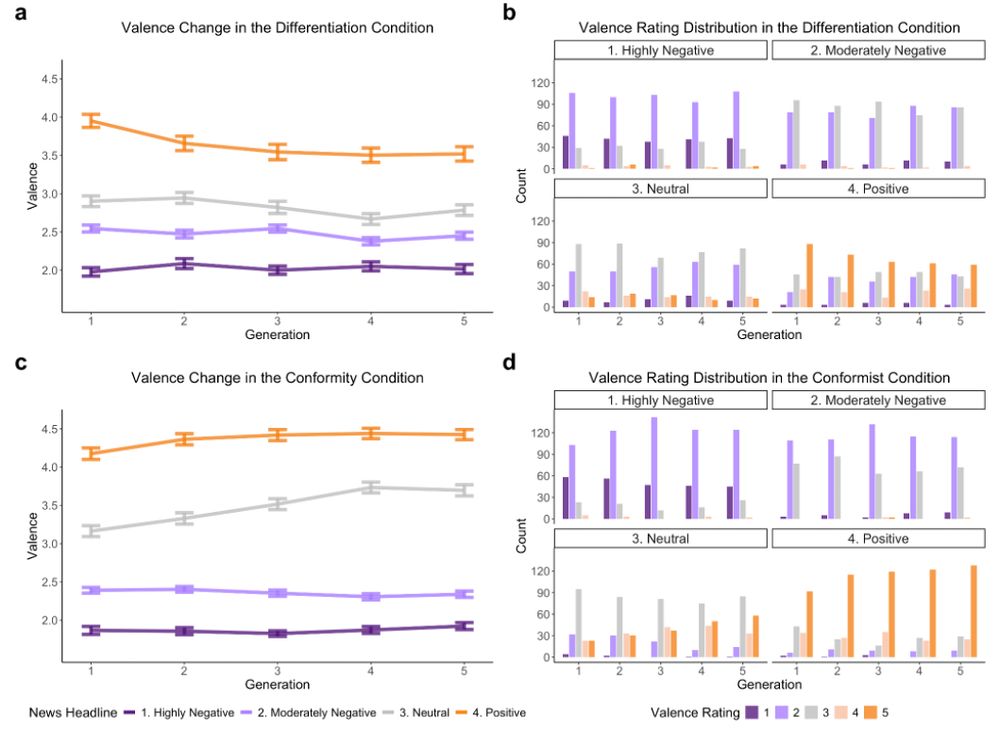
September 26, 2025 at 8:30 PM
Coolest evidence for differentiation as a cause might be an experiment (n=4000) simulating a comment thread
Incentivizing comment uniqueness (but not conformity) leads negative discourse to rise over time
Coauthored w @williambrady.bsky.social, @ycleong.bsky.social, Yutong Jiang, and Alex Koch
Incentivizing comment uniqueness (but not conformity) leads negative discourse to rise over time
Coauthored w @williambrady.bsky.social, @ycleong.bsky.social, Yutong Jiang, and Alex Koch
🚨New preprint🚨
osf.io/preprints/ps...
In a sample of ~2 billion comments, social media discourse becomes more negative over time
Archival and experimental findings suggest this is a byproduct of people trying to differentiate themselves
Led by @hongkai1.bsky.social in his 1st year (!) of his PhD
osf.io/preprints/ps...
In a sample of ~2 billion comments, social media discourse becomes more negative over time
Archival and experimental findings suggest this is a byproduct of people trying to differentiate themselves
Led by @hongkai1.bsky.social in his 1st year (!) of his PhD

September 26, 2025 at 8:30 PM
🚨New preprint🚨
osf.io/preprints/ps...
In a sample of ~2 billion comments, social media discourse becomes more negative over time
Archival and experimental findings suggest this is a byproduct of people trying to differentiate themselves
Led by @hongkai1.bsky.social in his 1st year (!) of his PhD
osf.io/preprints/ps...
In a sample of ~2 billion comments, social media discourse becomes more negative over time
Archival and experimental findings suggest this is a byproduct of people trying to differentiate themselves
Led by @hongkai1.bsky.social in his 1st year (!) of his PhD
@helenamiton.bsky.social and I have a new paper out:
www.sciencedirect.com/science/arti...
Past theories focus on how we evolve complex technologies (jet engines), but neglect cultural innovations that help us operate these technologies (pilot checklist)
Paper has tons of examples and new theory!
www.sciencedirect.com/science/arti...
Past theories focus on how we evolve complex technologies (jet engines), but neglect cultural innovations that help us operate these technologies (pilot checklist)
Paper has tons of examples and new theory!


September 5, 2025 at 8:46 PM
@helenamiton.bsky.social and I have a new paper out:
www.sciencedirect.com/science/arti...
Past theories focus on how we evolve complex technologies (jet engines), but neglect cultural innovations that help us operate these technologies (pilot checklist)
Paper has tons of examples and new theory!
www.sciencedirect.com/science/arti...
Past theories focus on how we evolve complex technologies (jet engines), but neglect cultural innovations that help us operate these technologies (pilot checklist)
Paper has tons of examples and new theory!
We find that communion words are converging in semantic space—extending work on the collapse of morality into a single dimension (cdr.lib.unc.edu/downloads/g7...)
But words about agency/competence are diverging in semantic space. They are becoming less related to each other over time
But words about agency/competence are diverging in semantic space. They are becoming less related to each other over time
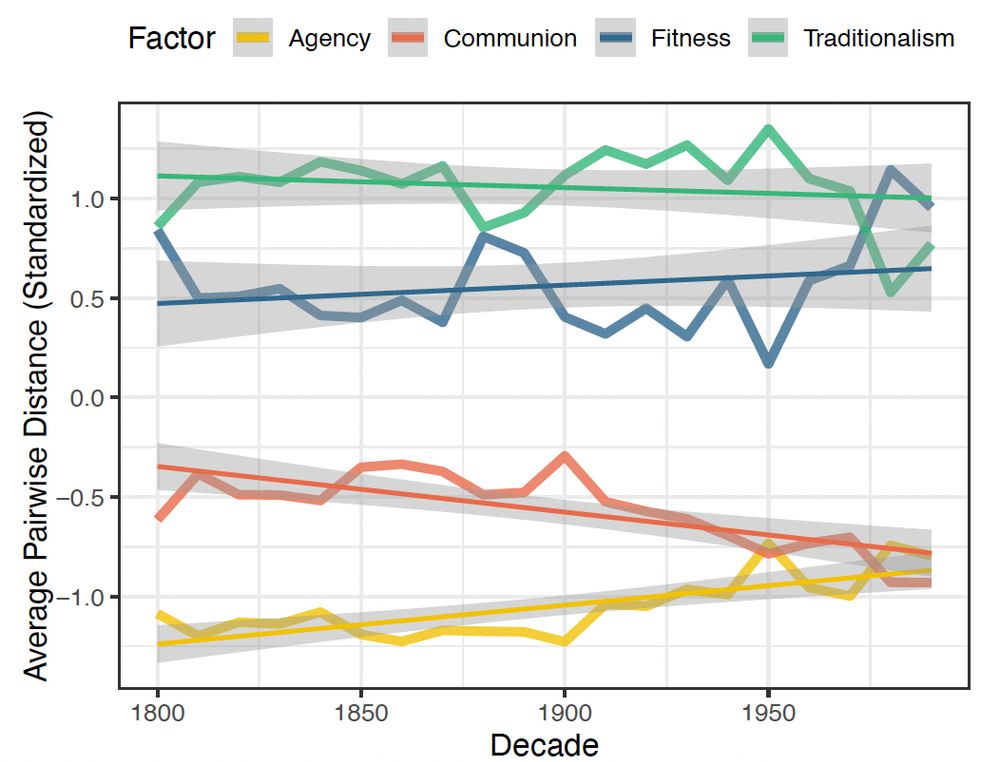
July 22, 2025 at 3:36 PM
We find that communion words are converging in semantic space—extending work on the collapse of morality into a single dimension (cdr.lib.unc.edu/downloads/g7...)
But words about agency/competence are diverging in semantic space. They are becoming less related to each other over time
But words about agency/competence are diverging in semantic space. They are becoming less related to each other over time
We also see interesting trends in the semantic coherence of these factors
We calculate coherence by looking at clustering in semantic space over time from word embeddings
Here are clusters of words projected based on their 19th and 20th century embeddings
We calculate coherence by looking at clustering in semantic space over time from word embeddings
Here are clusters of words projected based on their 19th and 20th century embeddings
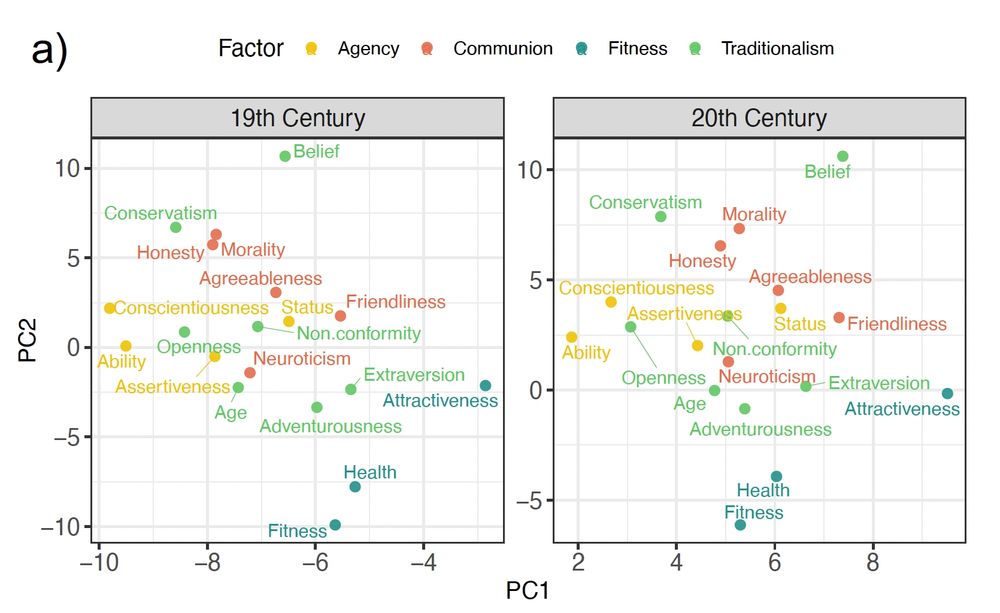
July 22, 2025 at 3:36 PM
We also see interesting trends in the semantic coherence of these factors
We calculate coherence by looking at clustering in semantic space over time from word embeddings
Here are clusters of words projected based on their 19th and 20th century embeddings
We calculate coherence by looking at clustering in semantic space over time from word embeddings
Here are clusters of words projected based on their 19th and 20th century embeddings
The small change we do see is a surge of “traditionalism” words around the rise of participatory democracies in Europe
“Conservativism-liberalism” is the “youngest” trait dimension by date of introduction
“Conservativism-liberalism” is the “youngest” trait dimension by date of introduction
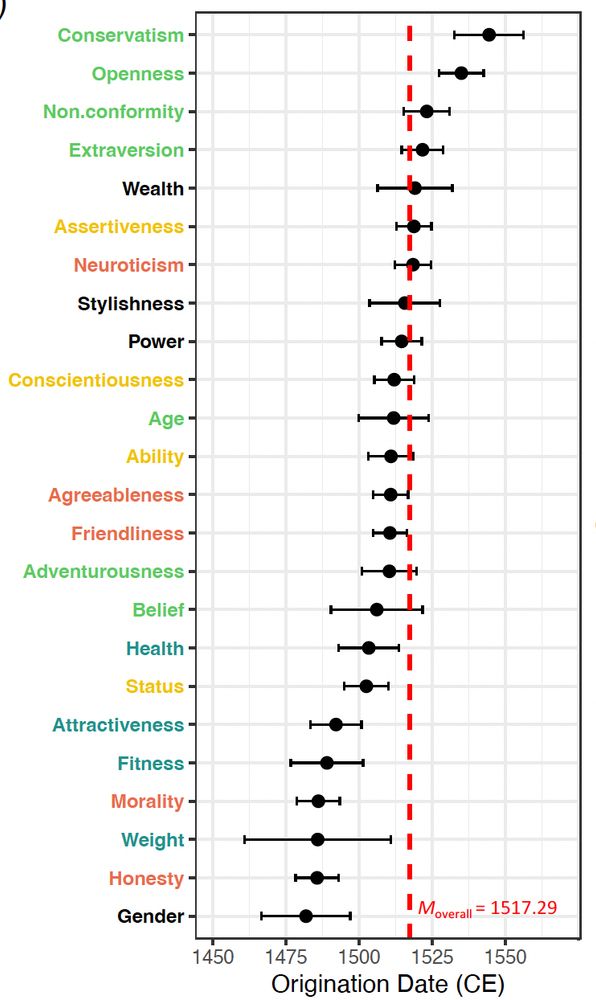
July 22, 2025 at 3:36 PM
The small change we do see is a surge of “traditionalism” words around the rise of participatory democracies in Europe
“Conservativism-liberalism” is the “youngest” trait dimension by date of introduction
“Conservativism-liberalism” is the “youngest” trait dimension by date of introduction
Finally, we look at the history of trait words using dates of origin from the Oxford English Dictionary
This plot shocked me – our trait vocabulary has been remarkably stable over time
We have always had more words about communion and the fewest words about fitness
This plot shocked me – our trait vocabulary has been remarkably stable over time
We have always had more words about communion and the fewest words about fitness

July 22, 2025 at 3:36 PM
Finally, we look at the history of trait words using dates of origin from the Oxford English Dictionary
This plot shocked me – our trait vocabulary has been remarkably stable over time
We have always had more words about communion and the fewest words about fitness
This plot shocked me – our trait vocabulary has been remarkably stable over time
We have always had more words about communion and the fewest words about fitness
Are there more negative or positive trait words? I once assumed there were more negative words because of negativity dominance
The real story is complicated
Communion dimensions are indeed filled with negative words.
But we have more positive words about agency, traditionalism, and fitness
The real story is complicated
Communion dimensions are indeed filled with negative words.
But we have more positive words about agency, traditionalism, and fitness

July 22, 2025 at 3:36 PM
Are there more negative or positive trait words? I once assumed there were more negative words because of negativity dominance
The real story is complicated
Communion dimensions are indeed filled with negative words.
But we have more positive words about agency, traditionalism, and fitness
The real story is complicated
Communion dimensions are indeed filled with negative words.
But we have more positive words about agency, traditionalism, and fitness
Most trait dimensions are evaluative – the have positively and negatively valenced poles (it is good to be friendly and bad to be unfriendly)
But some dimensions are not. Communion and agency are more evaluative than traditionalism or fitness dimensions
But some dimensions are not. Communion and agency are more evaluative than traditionalism or fitness dimensions

July 22, 2025 at 3:36 PM
Most trait dimensions are evaluative – the have positively and negatively valenced poles (it is good to be friendly and bad to be unfriendly)
But some dimensions are not. Communion and agency are more evaluative than traditionalism or fitness dimensions
But some dimensions are not. Communion and agency are more evaluative than traditionalism or fitness dimensions
For example, we find that Communion words are highly clustered (eg. words expressing friendliness tend to also express morality)
But words about traditionalism are spread across the network, closely knit with communion and agency
But words about traditionalism are spread across the network, closely knit with communion and agency
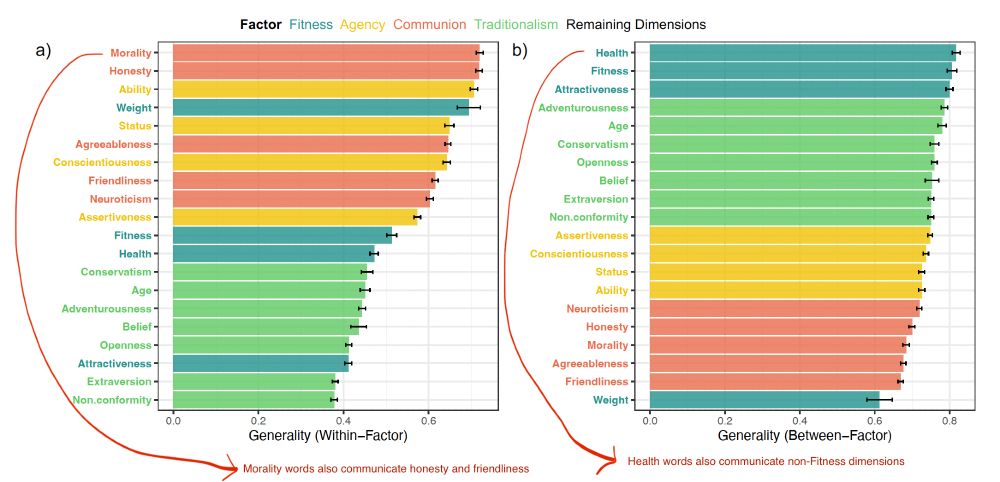
July 22, 2025 at 3:36 PM
For example, we find that Communion words are highly clustered (eg. words expressing friendliness tend to also express morality)
But words about traditionalism are spread across the network, closely knit with communion and agency
But words about traditionalism are spread across the network, closely knit with communion and agency
Although this FACT model is interesting and parsimonious, it masks variation within factors, and links between factors
The network below shows all words connected by their overlapping semantics.
The FACT factors partly organize the network, but lots of complexity remains
The network below shows all words connected by their overlapping semantics.
The FACT factors partly organize the network, but lots of complexity remains
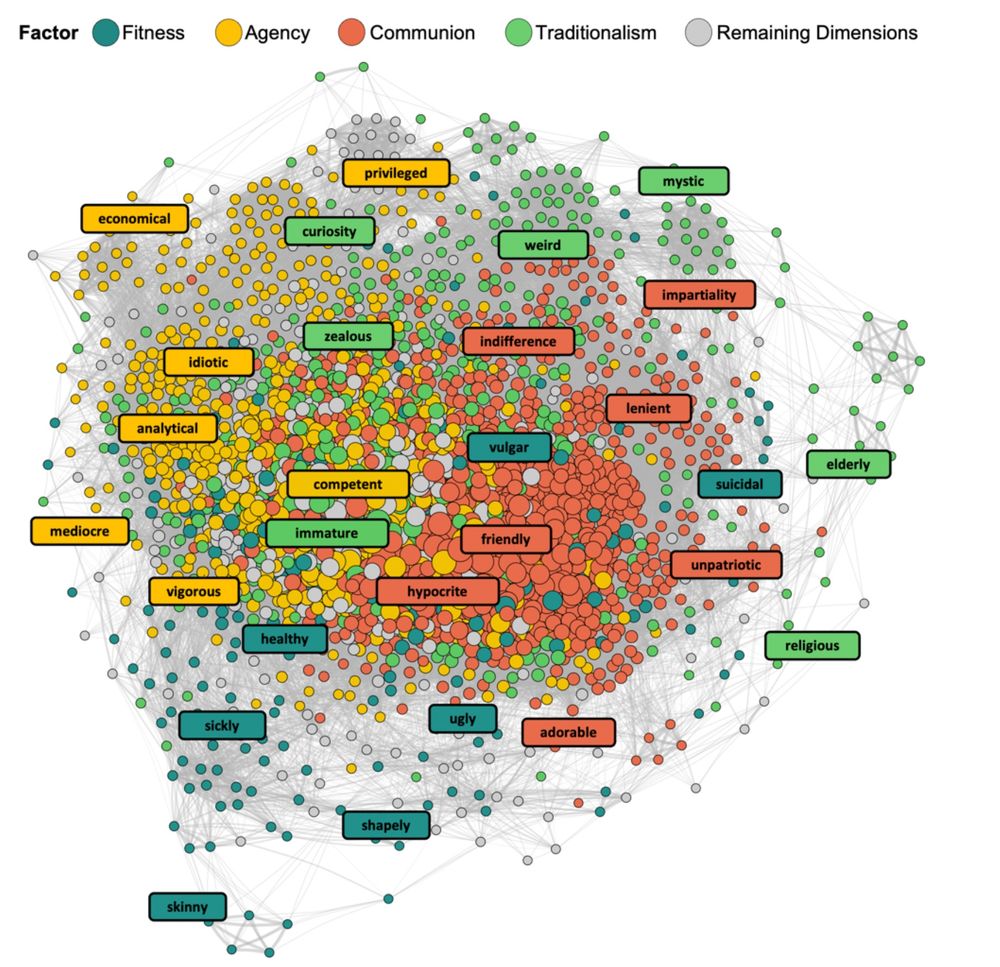
July 22, 2025 at 3:36 PM
Although this FACT model is interesting and parsimonious, it masks variation within factors, and links between factors
The network below shows all words connected by their overlapping semantics.
The FACT factors partly organize the network, but lots of complexity remains
The network below shows all words connected by their overlapping semantics.
The FACT factors partly organize the network, but lots of complexity remains
In an EFA, these 24 dimensions reduced to a four-dimension FACT model
Fitness (e.g., Attractiveness)
Agency (e.g., Assertiveness)
Communion (e.g., Morality)
Traditionalism (e.g., Conservatism)
Our model contains parts of prior models, most notably the ABC model of social evaluation
Fitness (e.g., Attractiveness)
Agency (e.g., Assertiveness)
Communion (e.g., Morality)
Traditionalism (e.g., Conservatism)
Our model contains parts of prior models, most notably the ABC model of social evaluation

July 22, 2025 at 3:36 PM
In an EFA, these 24 dimensions reduced to a four-dimension FACT model
Fitness (e.g., Attractiveness)
Agency (e.g., Assertiveness)
Communion (e.g., Morality)
Traditionalism (e.g., Conservatism)
Our model contains parts of prior models, most notably the ABC model of social evaluation
Fitness (e.g., Attractiveness)
Agency (e.g., Assertiveness)
Communion (e.g., Morality)
Traditionalism (e.g., Conservatism)
Our model contains parts of prior models, most notably the ABC model of social evaluation
After collecting the words, we turned to their semantic structure
We took 24 dimensions from a review of personality and psych science lit. Then Prolific workers rated all words on these dimensions
This plot shows how some words are generalized (relevant to many dimensions); others are specific
We took 24 dimensions from a review of personality and psych science lit. Then Prolific workers rated all words on these dimensions
This plot shows how some words are generalized (relevant to many dimensions); others are specific
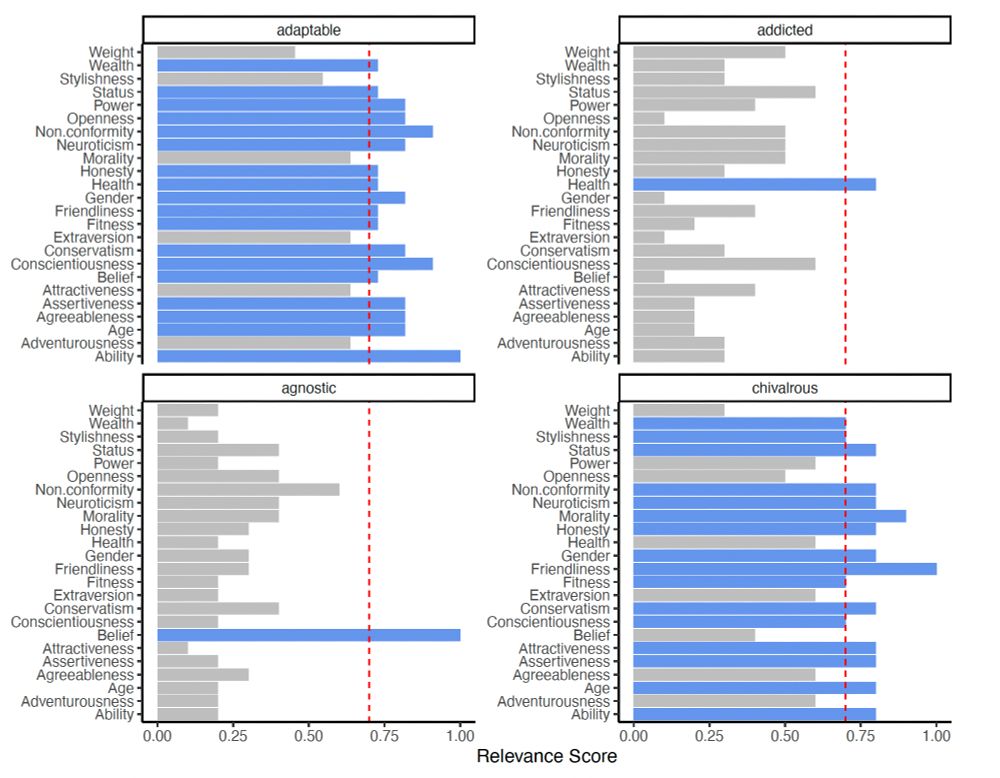
July 22, 2025 at 3:36 PM
After collecting the words, we turned to their semantic structure
We took 24 dimensions from a review of personality and psych science lit. Then Prolific workers rated all words on these dimensions
This plot shows how some words are generalized (relevant to many dimensions); others are specific
We took 24 dimensions from a review of personality and psych science lit. Then Prolific workers rated all words on these dimensions
This plot shows how some words are generalized (relevant to many dimensions); others are specific
One observation from building this list is that being a “trait word” is not black and white
Traits are natural categories with fluid boundaries. Some words are almost exclusively used as traits, but many have multiple meanings
Our approach gives words a continuous probability of being traits
Traits are natural categories with fluid boundaries. Some words are almost exclusively used as traits, but many have multiple meanings
Our approach gives words a continuous probability of being traits
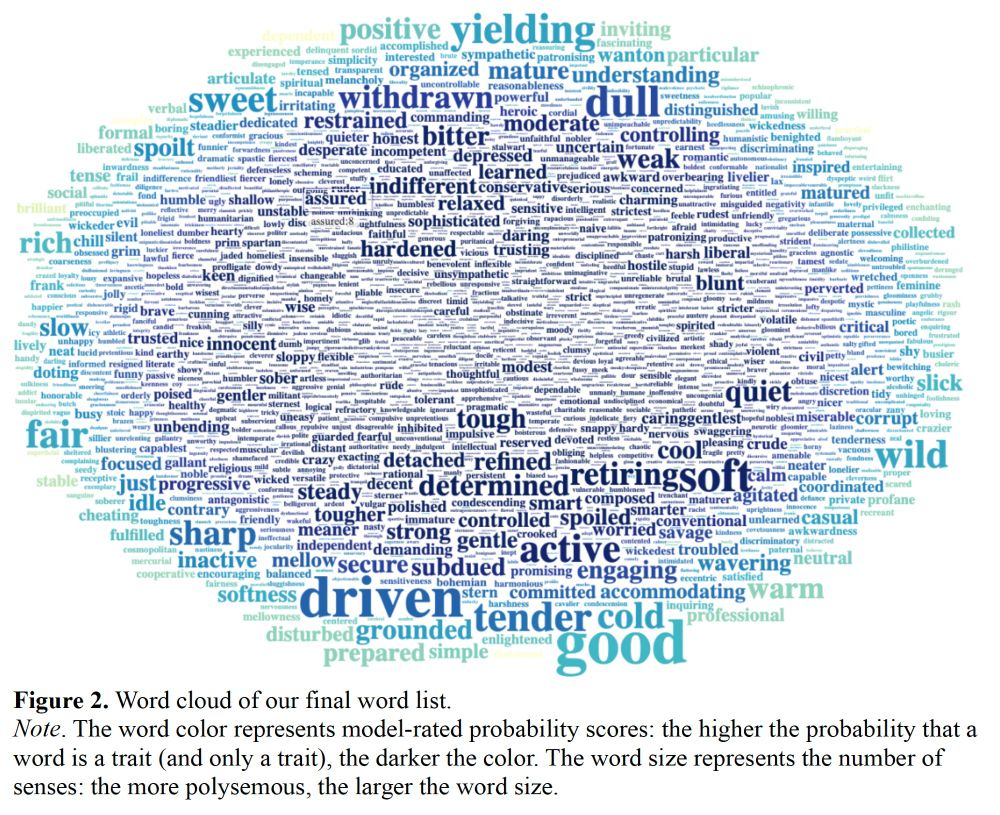
July 22, 2025 at 3:36 PM
One observation from building this list is that being a “trait word” is not black and white
Traits are natural categories with fluid boundaries. Some words are almost exclusively used as traits, but many have multiple meanings
Our approach gives words a continuous probability of being traits
Traits are natural categories with fluid boundaries. Some words are almost exclusively used as traits, but many have multiple meanings
Our approach gives words a continuous probability of being traits
We host this trait list on our OSF page (osf.io/7k4yj/files/...), freely available to all
All traits are linked to:
-A definition
-Probability of being a trait word
-Loading on 24 dimensions (e.g., friendliness, openness)
-Date of origin
-Number of meanings
All traits are linked to:
-A definition
-Probability of being a trait word
-Loading on 24 dimensions (e.g., friendliness, openness)
-Date of origin
-Number of meanings

July 22, 2025 at 3:36 PM
We host this trait list on our OSF page (osf.io/7k4yj/files/...), freely available to all
All traits are linked to:
-A definition
-Probability of being a trait word
-Loading on 24 dimensions (e.g., friendliness, openness)
-Date of origin
-Number of meanings
All traits are linked to:
-A definition
-Probability of being a trait word
-Loading on 24 dimensions (e.g., friendliness, openness)
-Date of origin
-Number of meanings

